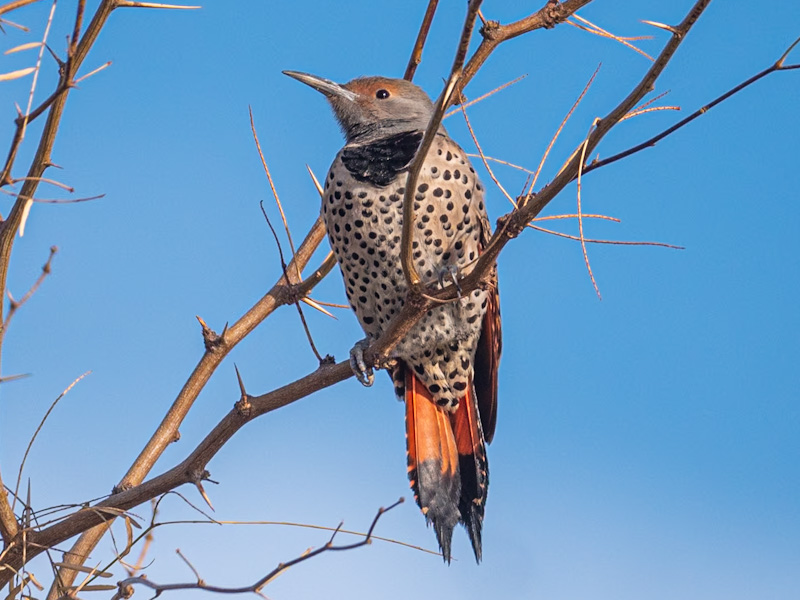
Common Name: Northern Flicker, yellowhammer, clape, gaffer woodpecker, harry-wicket, heigh-ho, wake-up, walk-up, wick-up, yarrup, and gawker bird
Scientific Name: Colaptes auratus
Subspecies: There are 10 subspecies , the one around Las Vegas is the Western Red-shafted Flicker (Colaptes auratus cafer). Roughly speaking, there is a yellow shafted group east of the Rocky Mountains and a red shafted group west of the Rocky Mountains. The two groups interbreed producing intergrade hybrids mostly in the west.
Order/Family: Piciformes/Picidae
Description: The western red-shafted flicker (Colaptes auratus cafer) resides in western North America. It is red under the tail and underwings and has red shafts on its primaries. It has a beige cap and a gray face. Males have a red mustache. A necklace-like black patch occupies the upper breast, while the lower breast and belly are beige with black spots. Males can be identified by a black (in the eastern part of the species’ range) or red (in the western part) mustachial stripe at the base of the beak, while females lack this stripe. The tail is dark on top, transitioning to a white rump which is easily identified as the flicker flys away. Subspecific plumage is variable.
Distribution: It is native to most of North America, parts of Central America, Cuba, and the Cayman Islands, and is one of the few woodpecker species that migrate. Northern flickers are partial migrants, in which some southern populations are completely non-migratory. Those that do migrate tend to begin their spring migration towards the beginning of April and make their return between September and October. in Las Vegas they are non-migratory.
Habitat: Northern flickers may be observed in open habitats near trees, including woodlands, edges, yards, and parks. In the western United States, one can find them in mountain forests all the way up to the tree line.





Intergrade or Hybrid Northern Flicker


An intergrade is the product of two subspecies or subspecies groups, and a hybrid is the product of two species. The two groups most birders are familiar with are the Yellow-shafted Northern Flicker (auratus group, seen east of the Rocky Mountains) and the Red-shafted Northern Flicker (cafer group seen roughly west of the Rocky Mountains). The intergrade birds often have a variable appearance, I have included a page on some of the known versions. The Northern Flicker pictured above has a v-shaped red area on the back of the head, yellow shafted and dark gray/red malars.
References:
Northern Flicker Intergrades – Red-shafted vs Yellow-shafted Flickers
